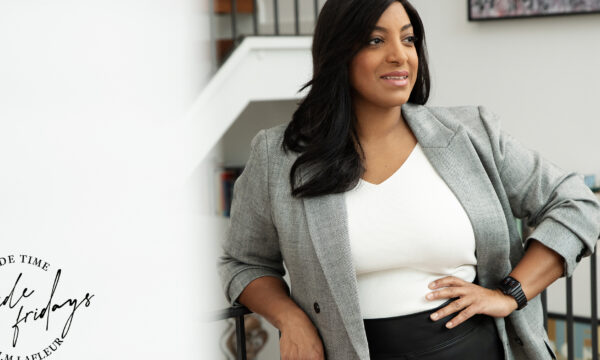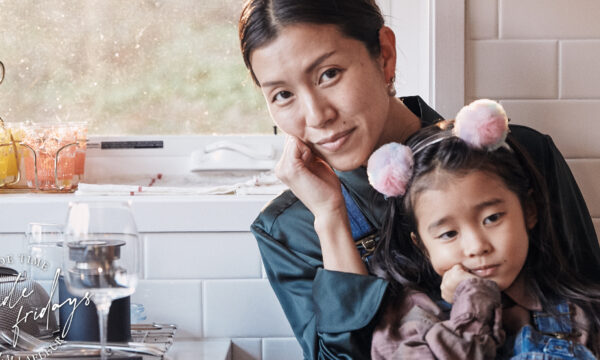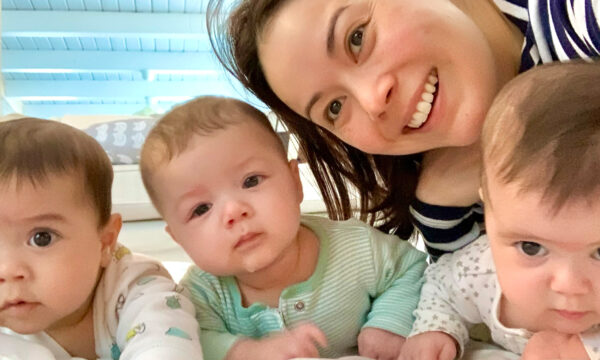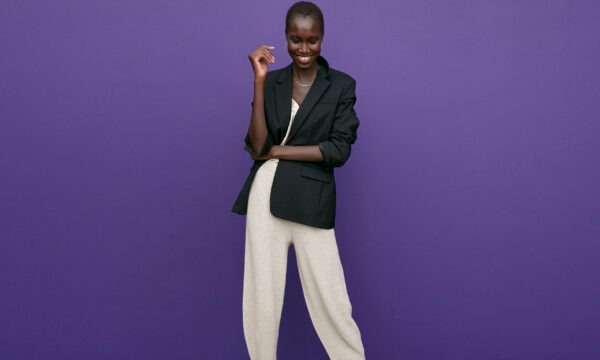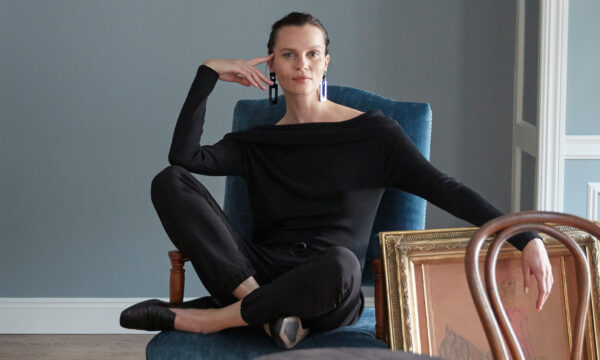
Photo of Véronique Hyland (top) ©Meredith Jenks/Trunk Archive
Has Fashion Changed for Good? M.M.’s Founders Consult Style Expert Véronique Hyland to Find Out
Three industry pros look toward the future of fashion with hope.
When M.M.LaFleur was founded almost a decade ago, getting dressed for work and life looked very different than it does now. Our co-founders, Sarah LaFleur and Miyako Nakamura, had set out to fill a gap in the market: beautiful, fuss-free clothing for women working in business-casual and business-formal offices. Fast forward to today, and M.M.’s selection includes not only the blazers and tailored dresses of our early years, but also the comfortable jeans, chic sweatshirts, and high-quality T-shirts that have come to define so many women’s work-life wardrobes.
But how did we get from dresses and suits to the Power Casual wardrobe we’re living in now? To help trace the meaning and context behind M.M.’s evolution, Sarah and Miyako sat down for a chat with Elle’s fashion features director, Véronique Hyland, whose debut book, Dress Code, comes out on March 15th. Read on for their conversation about the casualization of workwear, why our old definition of “working woman” doesn’t make sense anymore, and how to make getting dressed fun again.
Want more M Dash?
Sign up for our weekly newsletter.
Thank you!
ON THE EVOLUTION OF FASHION—AND M.M.—OVER THE DECADE
Véronique: Around 10 years ago, the fashion world was sort of pre-athleisure—athleisure existed, but it didn’t have such a big influence on the way we dress for work. For example, people were not wearing sneakers to work—or if they were, they were doing the thing where you change from sneakers to work shoes once you get to the office. There was a sense that you shouldn’t bring your personal style or individuality to the workplace. It was like, don’t bring your whole self to work.
I remember reading a career guide when I first started working that said, “You should never come to the office with wet hair,” and maybe that’s still true etiquette-wise, but the implication was, “because you don’t want people to see you as a human, as someone who was running late.” I think it’s interesting, because it ties into changing ideas of femininity and what feminine self-presentation is, but also who workers are expected to be and how much of yourself you can reveal at work.
Sarah: I totally agree with that. I was in that formal corporate world for the first five years of my career. I was also in client services, and there was this idea that you should always dress to be client-facing. That was very much ingrained into my head.
When we first started the business, our employees showed up to work in business-casual. We were all in dresses or slacks with button-downs, even though we were a small startup. But there came a point in the business, around 2017, where we started to see that the younger employees who were joining the company weren’t wearing our products as much as in 2015 and 2016. And to me, that was a sign. We already understood that the workplace was evolving, and Miyako and I ended up flying out to San Francisco and doing focus groups with women who worked in tech, trying to understand their distinct wardrobe challenges.
Miyako: In the focus group, there was a woman wearing a cashmere hoodie, and she looked very cool in it. I remember imagining that M.M. could carry something like it someday, but it was so different from what we were offering at the time. And now, if you look at our assortment, the Judith hoodie [which was inspired by that conversation] fits in perfectly. We had a mental shift around that time. We had to ask ourselves what dressing for the workplace should look like, as well as the audience we wanted to speak to.
Sarah: We were very singularly focused when we first launched in 2013. Partly because of my background, but our customers were mainly management consultants, bankers, lawyers, and doctors. Now, the professions we serve are much more varied. And I think that’s the result of both the corporate world getting more casual, and, hopefully, our clothing having wider appeal to more women.

The Mila top and Elizabeth top.
ON THE CASUALIZATION OF WORKWEAR
Véronique: I think it’s a combination of athleisure becoming more acceptable and everyday clothing leaning more toward athleisure. As you mentioned, a cashmere hoodie isn’t something we would’ve seen back in the day. Tech had a big influence on non-tech companies, too. Other companies started being run like startups and adopting the same dress codes and philosophies.
The shift away from uniforms is also worth noting. In offices in the fifties that I write about, like the one in The Man in the Gray Flannel Suit (both the book and the movie), everyone dressed pretty much alike and wore a uniform. The workplace was largely dominated by white men, and the dress code reflected that. And then, if you think about when more women started to enter the workforce in the eighties, for example, people were going for that Melanie Griffith in Working Girl kind of look. In more recent years, I think people have wanted to move away from that and not be as literal and corporate with their clothing.
Sarah: I agree. It’s also interesting to see how regional it is. We have a store in D.C., and the product mix in that store feels like New York circa 2015. I don’t mean that in a stylistic sense, but more in terms of what women are expected to wear for work. In D.C., there’s still a heavy focus on suiting and tailored work dresses, largely because of the government jobs there, whereas in New York, we’re seeing much more flexibility.
One of the things I loved about your book was your discussion of normcore—the trend of everyone dressing the same. It brings up the question, what could the return to personal style look like? Where is that going to come through? And where do you think that impetus is coming from?
Véronique: I think normcore was a reactionary thing, where the idea of personal style and being different had been heavily pushed on people. So the only way to rebel was to do the opposite and kind of look the same as everyone else. But the pendulum is constantly swinging back and forth, and now, people are more interested in looking different and doing their own thing.

Left: The Lilia jacket, Rogala culottes, and Claressa earrings.
Right: The Porter jacket, Marcia T-shirt, Milo jeans, and Claressa earrings.
ON REDISCOVERING THE JOY OF GETTING DRESSED
Sarah: Before M.M. shifted to focus on Power Casual clothing, I used to change out of my work clothes as soon as I got home. Whereas now, whatever I put on in the morning is what I’ll be wearing until I change into my PJs. Part of this is because of lifestyle changes—my family is living in rural Connecticut, and I usually come to New York Monday through Wednesday or Tuesday through Thursday, so I feel like I’m always commuting and carrying luggage. It’s stuff I couldn’t imagine myself doing still wearing a dress and heels, or even a tailored suit, on a daily basis. But does that mean that I’m going to wear athleisure to work? No—I love it for a weekend coffee run, but it’s not my go-to.
To me, dressing in Power Casual speaks to what Coco Chanel did in the 1920s. It’s the idea that you don’t have to get dressed five different times in a day. I want to be able to put on one outfit and know I can do everything I need to do in it.
Miyako: I’ve gone back and forth on what makes our clothes different from other fashion brands, and I think it’s about something deeper than aesthetics. When I’m designing new pieces, I try to put myself into our customer’s psychological state—and the goal is that when she wears M.M., she feels confident. She could be wearing something that feels like a yoga outfit, but she’ll still be seen as a “professional woman” wherever she goes.
To me, it’s about that emotional support we’re providing to her. My priorities as a designer are the quality of the clothes and the ability to make women feel beautiful and relevant in the world today.
Sarah: I think “relevant” is a really important word. Sometimes, I just wake up and feel completely exasperated about the state of the world, like, “I cannot believe we’re going into year three of this.” And for me, putting on clothing that’s not yoga pants is a way of taking control of the situation, feeling relevant, and feeling connected to the people around me.
Véronique: Yeah, absolutely. It’s really gratifying when you can find joy in what you’re putting together. What I’m seeing in terms of design is that people want that comfort that they’ve gotten used to, but they want to elevate it a little bit. I’m seeing a lot of looser pants that are styled almost like sweatpants, but made from an elevated fabric. Something like a cashmere hoodie would be another good example.
People also don’t want to sacrifice the positive changes they’ve made during the pandemic. I mean, I like high-waisted jeans, but I don’t know how I wore them every day. Tights are another big thing I’m not dying to start wearing again. But like I said, the pendulum will swing, and we’re not going to see the tie-dye sweatsuit moment extend. I think people have burned out on that.

The Molly cardigan, Charli top, and Marijane pants.
ON REDEFINING THE “WORKING WOMAN”
Sarah: If someone had asked me circa 2019, “What is M.M.LaFleur?,” I would have said, “We design clothing for working women.” And I would have assumed that people knew I was talking about women who work in offices, because our line at the time was primarily made up of classic office pieces, like dresses, button-downs, and trousers. But of course, “working women” is much broader than that. In fact, Miyako and I were just talking about how being a stay-at-home mom is probably the hardest job. It’s been a self-reflecting moment, realizing the narrow-mindedness I had in my understanding of working women.
I was recently at this cafe, and when I saw the woman at the cash register, I was like, “Oh my God, I’ve seen you before. Where have I seen you?” And I realized she used to work as the manager at another cafe uptown. I was like, “Why’d you choose to switch companies?” And she said, “You know what, the responsibility got to be too much, and I just had to take a step down and take a break.” I think so many people can relate. It feels like we’re having this pressure-cooker moment, and a lot of people are saying, “I don’t necessarily want the prestige that comes with being a store manager. I actually kind of need to take a break.”
Up until early 2020, there was definitely a “you go, girl” and “women, get to the top of the ladder” moment happening. And I would say—definitely among my circle of friends, and I think among many of our customers, too—a lot of us are not so sure if that’s something we even want to shoot for. It doesn’t feel aspirational anymore, and that’s another way in which we’re reframing the concept of success. It’s so much broader than what you’re doing in your nine-to-five life.
Véronique: One thing I’m really fascinated by is the evolution of work over the years and how that plays into fashion and our expectations of women. During World War II, women entered the workforce because men were largely off fighting, and the fashion accommodated that change. Suddenly, it was okay for women to wear pants and more “masculine” items. Then, when the war ended, there was an extreme shift back toward things like the pencil skirt, the hourglass silhouette, and the girdle.
It’s interesting to see the way in which “working women” has been defined so differently over the years. That’s got to be a challenge for you as designers, because there’s not really a set uniform. But that also gives you a larger canvas to paint on.
Miyako: I think it’s an exciting moment, because we have an opportunity to redesign and redefine what women should wear to live a life. And I think we all feel that life should be more liberated and revolve around more than just climbing up the ladder. We definitely cherish different things than we did 10 years ago. Our priorities have shifted, the world has shifted, and our clothes have shifted.
It’s interesting that you talk about normcore in your book, Véronique, because I do feel like fashion even 10 years ago was a lot more decorative. With the rise of normcore, everything became more “effortless.” It’s almost like the less you look like you care, the cooler you look. It’s a very tricky place to hit, but that’s the balance we’re trying to strike with the comfort, ease, and polish of Power Casual.

The Merritt jardigan, Malki top, Finley stretch pants, and Rowan flats.
ON WHERE WE GO FROM HERE
Sarah: Véronique, what fashion tip would you want to pass on to our readers? Having written your book and understanding the complexities that go into dressing for work, what’s a tip that women can take with them as they reemerge into the world?
Véronique: Find that balance of comfort and think about what elements of dressing you can bring from pandemic life into your (hopefully) post-pandemic and working life. Because, like I said, there are certain items of clothing that are just going to be non-starters going forward.
Also, find ways to let fashion bring you moments of joy and self-expression. I’m mindful of the fact that people are sometimes limited in what they can do with that, and that things like uniforms and more corporate environments don’t always allow for it. But even if it’s a small piece of flair, I think it’s important to have something that makes you feel like you.

The Theo sweater, Bevin dress, and Wangari earrings.
ON WHAT’S GIVING US HOPE ABOUT THE FASHION INDUSTRY
Véronique: I feel like people are really committing to environmental and labor sustainability. Because I interview so many new designers, it’s something that I’ve really noticed, especially with the people that I cover in London, because the UK is a bit ahead of us on some of this stuff. They’re not saying, “Oh, well, when I get to a certain point and it’s scalable, then I’ll figure out the whole eco piece of it.” They’re saying, “What can I do from the beginning?” It’s a non-negotiable for them.
Miyako: A lot of systems and processes have been broken and taken away for the better. I think now, more people have the tools to express themselves, so makers and wearers are getting closer to one another. I’ve been following a lot of Japanese craftspeople whose designs and products are extremely refined. I’m very, very impressed by what they sell in their booths—I feel like it’s equal to what used to be in fashion shows. I’m excited to see how the way we obtain and circulate clothes will evolve.
Sarah: I’m excited to say goodbye to normcore. And I’m so ready for people to have fun with fashion again! I’ve been watching the new Sex and the City, and for some of it, I’m just like, “This is totally over the top. Nobody dresses like this.” And yet, I love that they’re having fun with fashion.
I can only speak for myself, but I need more joy in my life right now. And if people can get that through the clothes they wear, then I love that. I hope we can continue to do that with the clothes that we make, and I hope that’s a role that fashion can continue to play in our world.






